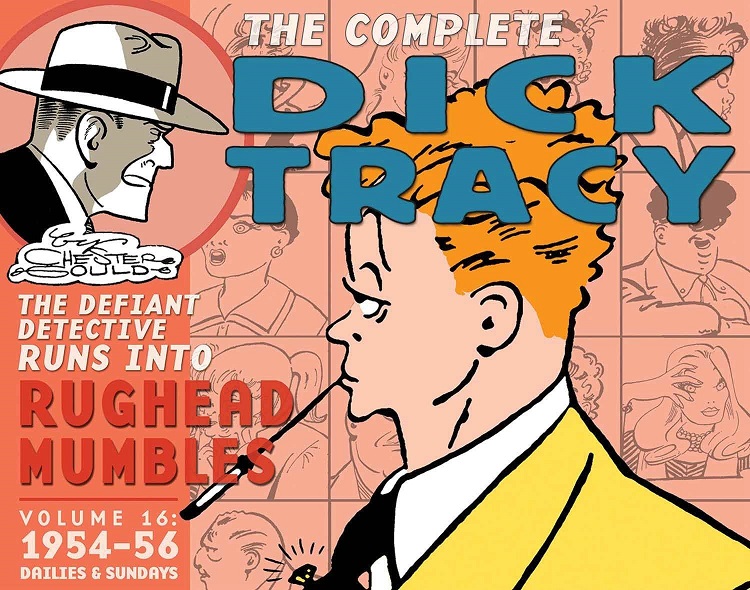
Chester Gould’s Dick Tracy comic strip debuted on October 4, 1931 and continues today under the creative team of by Joe Staton and Mike Curtis. Named after the lead character, a square-jawed, yellow-hat-and-jacket-wearing police detective, the strip became so popular it would be adapted to many media, including radio, films, and television. In 2007, The Library of American Comics and IDW Publishing began publishing The Complete Dick Tracy. Volume 16 presents the dailies and Sunday strips from October 25, 1954 – May 13, 1956.
The collection begins mid-case with Tracy and the police on the hunt for Rughead, a vain criminal frequently seen rubbing wig oil onto his toupee. It’s a foul concoction, as indicated by the many flies it draws. Rughead goes on the lam, but can’t stay away for long because he runs out of money. While Tracy is searching to bring Rughead to jail, crooks in the know are searching for Rughead’s stash.
The next case involves the murder of health nut George Ozone and the return of Mumbles, a popular villain believed dead, but his speech pattern gives him away to readers (as does the book cover). Bringing back Mumbles was a first for Gould, who usually had the bad guys meet deadly ends.
Tracy and his partner Sam Catchem had planned on taking summer vacations with their wives, but that gets gummed up when two boys find a skeleton in a suit buried inside an overpass. Oodles, who is nearly 500 lbs. and wears his hair combed so low on his face it covers his nose, is responsible at the behest of the dead man’s wife, who has been making monthly payments for the job. She’s not happy, especially when Tracy has her brought in for questioning. During this story, Lizz Worthington is introduced and she would go onto to become a policewoman that worked with Tracy.
Juvenile delinquency was all the rage in the mid-’50s and this book concludes with a couple of young hoods at the center. Joe Period made his bones as a wheelman and Gould seamlessly moves him from a minor character in one story to the main bad guy in the next. While on the run for two murders, he is assisted by Flattop’s kid, the son of what is arguably the strip’s most greatest villain.
This book was my first time reading Gould’s Dick Tracy, and it became quickly apparent why the strip was such a success. Gould is a great storyteller with words and images. The plots take unexpected turns that kept the stories engaging and always had me eager to get to the next panel. Bad guys frequently turn on each other, which helped complicate matters and kept the outcomes in doubt.
The characters are simple, though enjoyable. They are either good or bad with no gray area, and Gould usually makes sure the bad guys look as ugly on the outside as they are on the inside. “Nothing” Yonson’s face is particularly off-putting as all his features are scrunched into a tiny spot on his face. Tracy does whatever he needs to catch the bad guys and if that means breaking the law so be it, like when he steals a notepad out of a suspect’s house that provides him with information. He, and Gould, also have no qualms about violence and killing bad guys.
Gould’s art is also impressive. The panels feature a great amount of detail. He makes great use of inks when evoking shadows. The sequence of Tracy and Mumbles caught in the fog is especially well done. In the dailies, the figures are black while the background are many lines drawn to create fog, while the Sunday strips find the figures in the fog drawn as many lines. Speaking of Sunday strips, each starts with a note from the Crimestoppers textbook that offers advice about safety and how to find clues to solve crimes.
After reading The Complete Dick Tracy, Volume 16, there’s no mystery why Chester Gould’s work endures and deserves to be preserved. The strips offer well-told gritty crime dramas one panel at a time. Highly recommended.